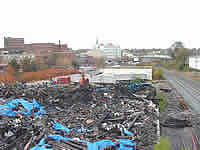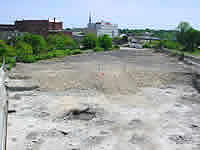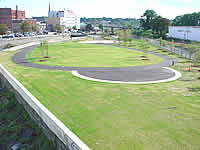Waste Site Cleanup & Reuse in New England
Fitchburg, MA Rubber Factory Contaminated Site Becomes an Urban Oasis
Success in EPA Brownfields Assessment Grant Program
Fitchburg, MA
(October 15, 2003)
Contacts
US EPA Brownfields Assessment Grant Enables The Hope Rubber Factory Site to Transform into the Beautiful Riverfront Park
The fenced in and charred foundation of the Hope Rubber Plant off Boulder Drive in the historic Fitchburg, Massachusetts was transformed from a contaminated and potentially dangerous urban eyesore to the beautiful and relaxing Riverfront Park complete with outdoor theater, nature trails, and expansive green lawns. This redevelopment was made possible in part by a 2001 Brownfields Assessment Grant of $200,000 from the US EPA Brownfields Program. The redevelopment of the over 1.6 acre site is part of the city Planning Department and Fitchburg Redevelopment Authority’s commitment to revitalization. The park has enabled this large New England community, hit hard by economic downfall in past years, to begin a period of economic and esthetic rebirth.
Bordering the Nashua River, the 28 square mile city, with a population of around 41,000 residents, is just fifty miles west of Boston and 25 miles north of Worcester. It encompasses open rural spaces and a relatively vacant urban core. With an unemployment rate nearly double the national average in 1999 and with almost 12% of the population below the poverty rate (5% above the state average) this troubled community was in need of help.
When the General Electric plant in town closed in 1998, over 600 residents were without a job and the number of deficient and vacant buildings, already apparent throughout the city, continued to grow. The GE shutdown spurred a needed urban renaissance within the city. By May of that year a complete Urban Renewal Plan was prepared and ready to be implemented. The selective renewal program targeted urban brownfields including the large and contaminated 40 Commercial Street location of the former Hope Rubber factory.
Hope Rubber, a plastic and rubber parts manufacturer, closed shop in the 1990s. The massive 35,000 square foot building remained untouched until the city Planning Department applied for an EPA Brownfields Assessment Grant. The $200,000 grant, received in 2001, enabled the Planning Department to hire an independent environmental assessment firm. TRC Environmental Corporation was chosen to perform Phase I, Phase II, and Risk Assessments on the site.
TRC’s assessments demonstrated that the abandoned industrial property contained surface soils contaminated with lead and arsenic that exceeded applicable MCP Reportable Concentrations. Groundwater samples demonstrated that additional contaminants exceeded acceptable MCP levels. These chemicals posed an unacceptable risk to human health. Four underground storage tanks (USTs) were also found on the property by TRC and later removed by Cyn Environmental Services on behalf of the former owner of the property - Commercial Street Realty Trust (CSRT). The USTs were found to contain fuel oil and liquids. One UST had a small leak that leached petroleum hydrocarbons and volatile organic compounds (VOCs) into the surrounding soil. Asbestos-containing materials (ACMs) were also found within the building by TRC and later removed by Patriots Environmental Corporation.
Within just two years,155 cubic yards of contaminated materials were removed, eighteen inches of clean cover material was put into place, the Riverside Park was developed, built, and opened with a spectacular summer concert in its new theater on August 23, 2003.
The park was a collaborative effort that included residents in every aspect of the clean-up and redevelopment. From small details like bench and street lamp preference to the huge task of architectural design firm selection, the local community lent their collaborative hands to the effort. The Riverfront Park Citizens Committee, made up of business leaders, residents, and government officials, hired the Cambridge, MA architectural firm, Carol R. Associates, to design the project. Construction of the park was completed by Weymouth, MA developer, Northern Construction Services.
Phase I of the parks creation is now complete. The almost $530,000 project was funded by both the Executive Office of Environmental Affairs and Fitchburg Redevelopment Authority and included removing debris, filling the building hole, paving of walkways, lighting, benches, plants, grass, trees, fencing and more.
The Riverfront Park, which meanders along the Nashua River in downtown Fitchburg, is now the key element in the city’s proposed $43 million Fitchburg Urban Revitalization Program. The almost two-acre park includes a river promenade, green lawns and trees, and comfortable benches for residence to lunch and relax on. The park also plans to include a renovated railroad car to sell refreshments (highlighting the city’s historic cargo shipping past), an enormous band shell for musical and theatrical performances, and a structurally renovated Old Iron Bridge during the second phase of the Riverfront Park redevelopment. Phase II is expected to cost $700,000.
“The Fitchburg Riverfront Park provides people with a place to enjoy the outdoors and the river as a community,”said Lisa Wong of the Fitchburg Economic Development Office. “It has proven that it has the potential to draw people back downtown.”
In 2003, the EPA awarded the Fitchburg Redevelopment Authority an additional $200,000 Assessment Grant so that 7 more brownfield sites in the community can be assessed for contaminants. Armed with this information the Fitchburg community will once again be prepared to reclaim a portion of the blighted urban compact and experience another environmental and economic victory like Riverfront Park.



